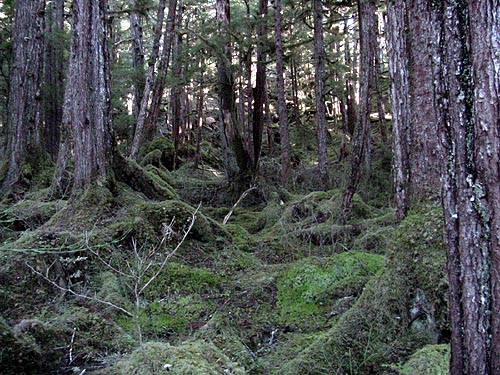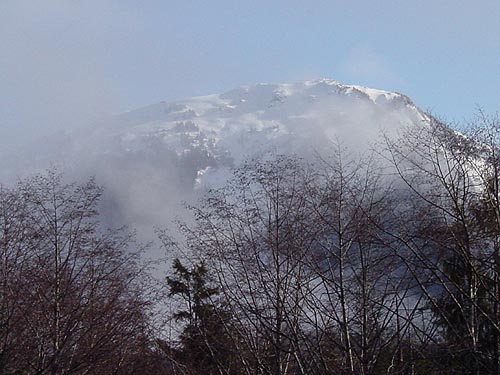 Chugach & Tongass National Forest Decisions Announced Today by Sitnews February 28 , 2003
Regional Forester Denny Bschor said, "I am pleased to sign a decision that continues protecting the Tongass. I am confident that this decision is the best possible." Bschor said, "I have decided that no additional Congressionally designated wilderness is needed on the Tongass National Forest at this time. I have therefore selected Alternative 1, the No Action Alternative, for three primary reasons. First, almost 40 percent of the Tongass National Forest is already designated, by Congress, as Wilderness, National Monument, or to other special land use allocation. Second, most of the rest of the Tongass is managed to remain in a largely untouched, wildland state for the next fifty years, and the rest is protected by a body of law, regulation, and policy that assures its long-term sustainability. Third, the communities and their associated economies are changing rapidly in Southeast Alaska, and I don't want to make commitments right now that will pre-empt future decisions important to the people who live here."  photo by Gigi Pilcher Bschor said his decision does not change the 1997 Forest Plan Revision. In a letter to the Planning Participants, Bschor wrote that about 22 percent of the Tongass remains zoned to Land Use Designations that could allow development, such as timber management and roads and about four percent of the Tongass is potentially available for timber harvest, with about half of that within inventoried roadless areas. Bschor said at this time, the wilderness level will remain at its current vast acreage and that this decision agrees with the recommendation from Forest Supervisor Tom Puchlerz. "An area twice the size of Maryland is wildland on the Tongass today," said Bschor. "Many people voiced opinions concerning timber harvesting. Under the Forest Plan, timber management will continue on 4% of the Tongass National Forest." Bschor said, "We appreciate the significant public comment the Tongass National Forest received on its analysis of wildlands. It was valuable information that helped us make this
Regional Forester Denny Bschor said, "In light of some of the public comment we received, let me make one clear distinction. These decisions are about recommending or not recommending lands in Alaska for wilderness designation by Congress. Neither the Tongass nor the Chugach wilderness recommendations are connected to the national roadless rule. These are not 'roadless' decisions." Bschor also reconfirmed the Forest Service's commitment to the importance of wildlands when he announced the agency was submitting the Chugach Forest Plan's wilderness recommendation for the Nellie Juan/College Fiord area to the current Congress. Bschor said, "This will be the first Wilderness recommendation sent to Congress by any Administration since 1984." The Tongass Record of Decision, signed by Bschor, keeps more than 90 percent of the 17-million-acre Tongass in a wildland status, and recommends no more wilderness. Acting Chugach Forest Supervisor Susan Rutherford said, "I"m very excited at the prospect of designated wilderness in Prince William Sound. If enacted by Congress, these 1.4 million acres will be the very first designated wilderness on the second largest national forest in the country. This area will be a spectacular addition to the National Wilderness Preservation System." Rutherford said they were pleased to learn that the Administration would submit the Chugach Wilderness legislative proposal to Congress this year.  Photo by Dan Hart Tongass Forest Supervisor Tom Puchlerz said, "We seriously looked at three criteria under the National Wilderness Act and applied those to our decision. The criteria are capability, availability, and need. Clearly, most wildlands on the Tongass are capable of being designated Wilderness. Most of them could be available under the Forest Plan. The most difficult strongest criterion addressed was the question of Need." Puchlerz said, "With 39% of the Tongass in designated wilderness, LUD II, and National Monuments, and most of the rest in some other kind of wildlands, we concluded there is no need for more designated wilderness today." Puchlerz said, "Carrying capacity for wildland recreation settings such as Wilderness far exceeds the current or projected demand by visitors or commercial outfitters and guides. Wildlife and fish-such as brown bears, gray wolves, bald eagles and five salmon species-are found on the Tongass forest in abundance. Many species that thrive here are rare or endangered in other states." Tongass Forest Supervisor Tom Puchlerz said, "Communities throughout the Tongass also depend on the forest for natural resources that maintain our Alaska lifestyle." He said this decision provides communities the opportunity to develop public facilities such as power lines, water supplies, and transportation on national forest lands. This is important to us because private land is very scarce in Southeast Alaska." "Private land is as rare in Southeast Alaska as Wilderness is in the lower 48. Under the Forest Plan, timber management will continue on 4% of the Tongass National Forest," Puchlerz said. According to Puchlerz and Rutherford, public input and consultation was invaluable and almost unprecedented in scope for both the Tongass and Chugach planning processes. "By our actions today we are guaranteeing that our grandchildren will have virtually the same Alaska national forests to visit and use that we have today," Bschor said. "It goes to the heart of the Forest Service"s mission- 'Caring for the Land and Serving People'. " The study was conducted over the past two years and during that time the USDF evaluated more than 100 separate roadless areas on the Tongass National Forest for capability, availability and need for formal Wilderness designation. The study was ordered by Judge James K. Singleton of the U.S. District Court for Alaska.
Related Information:
More detailed information concerning the Chugach wilderness proposal and the Tongass Wilderness SEIS can be found at:
Governor Murkowski's Remarks On Decision
|
||